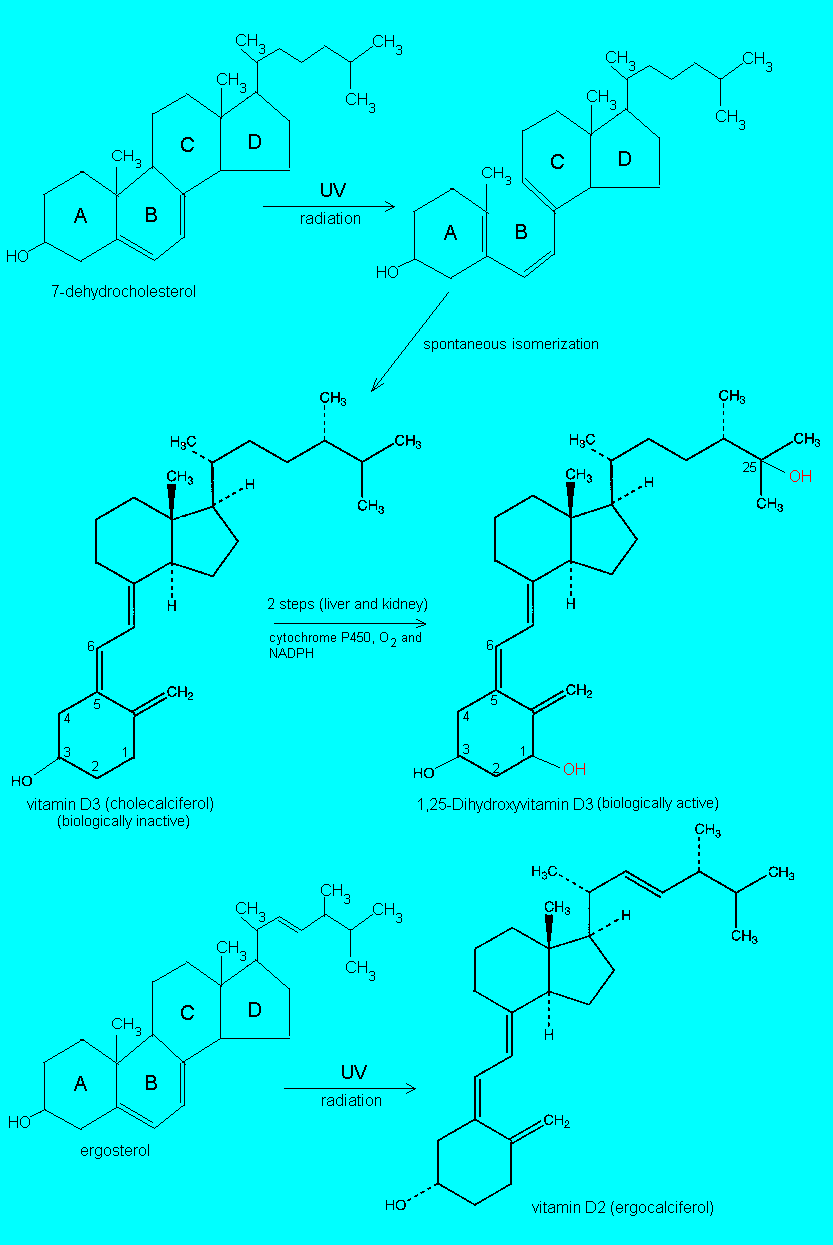|
Vitamin D
The D vitamins are sterol derivatives with hormone-like function. The natural form of the vitamin, i.e. vitamin D3 (cholecalciferol) is formed nonenzymatically in the skin of animals through the action of UV light on 7-dehydrocholesterol. Vitamin D2 is formed by the UV irradiation of the plant sterol ergosterol. It is noteworthy that both vitamins are inactive as such. 7-dehydrocholesterol in the epidermal layer of the skin absorbs solar UV (the effective range is 290-310 nm) and is converted to precholecalciferol, which in turn undergoes a spontaneous isomerization to cholecalciferol (vitamin D3). This form is not biologically active. Once formed cholecalciferol enters the circulation and is metabolized in the liver to 25-hydroxycholecalciferol (25(OH) D3). This form of the vitamin re-enters the circulation bound to its binding protein and is converted in the kidney to its biologically active form 1a-,25-hydroxycholecalciferol [1,25(OH)2vitamin D3, also known as calcitriol. Both hydroxylations are catalyzed by the microsomal P450 enzyme. Blood plasma phosphorus and parathyroid hormone among other factors are involved in the regulation of renal production of 1,25(OH)2D3. The production of this vitamin in the kidneys is tightly controlled as demonstrated by the fact that an increased intake of vitamin D or exposure to sunlight does not result in increased renal production of 1,25(OH)2D3. This form of the vitamin acts to increase serum calcium concentration by promoting the intestinal absorption of dietary calcium (1). As a result, there is an increased uptake of calcium by the bone tissue. Besides this, 1,25(OH)2D3 is involved in the regulation of cell growth and maturation, stimulation of insulin secretion and the modulation of the biological activity of activated T and B lymphocytes and macrophages. It is noteworthy that cells of the epidermal layer in the skin were shown to also be able to convert 25(OH) D3 to 1,25(OH)2D3 (2). However, it is not clear what is the share of skin cells in the overall active vitamin D3 production. Vitamin D3 is also known to possess anticancer activity by inhibiting cell cycle progression and inducing differentiation and apoptosis. In addition, vitamin D3 increases the activity of anticancer agents that trigger an overproduction of reactive oxygen species in target cells. Treatment of the MCF-7 breast cancer cell line with vitamin D3, in the absence of anticancer drugs resulted in a significant augmentation of oxidized GSH (oxGSH) and an increase in glutaraldehyde-3-phosphate dehydrogenase (GAPDH) activity (3). These results suggest that vitamin D3 is responsible for an increase in the overall cellular redox potential, as reflected in the oxGSH/redGSH ratio and the production of NADPH, which may contribute to the modulation of redox-sensitive enzymes and transcription factors that control cell cycle, differentiation and apoptosis. However, the role played by vitamin D3 in cancer prevention/treatment is far from being totally clear. For an update on vitamin D implication in cancer the reader is encouraged to look at this brief research article (4). It is worth mentioning that the precursor [25(OH) D3] to 1,25(OH)2 D3 thought until not long ago to be 'biologically inactive' was found to be able to induce in human macrophages stimulated with a mycobacterial lipoprotein, a peptide (cathelicidin) that exhibits antimicrobial activity (5). It has been recently shown that vitamin D3 deficiency is positively associated with an increased risk of cardiovascular disease in people with diabetes mellitus (6). Thus, macrophages from diabetics were cultured in the presence and absence of 1,25(OH)2 D3 and exposed to oxidized LDL (oxLDL). Vitamin D3 suppressed foam cell formation by inhibiting oxLDL uptake in diabetic subjects. On the hand, deletion of vitamin D3 receptor in macrophages from diabetics accelerated foam cells formation. These results clearly identify vitamin D3 receptor signaling pathway as a potential mechanism in turning macrophages into foam cells, which is a known step in atherosclerotic plaque formation. 
Some of the most important functions of the biologically active D vitamins are listed below:
References 1. DeLuca, H.F. (1986) Adv.Exp.Med.Biol. 196, 361-375. The metabolism and function of vitamin D. 2. Bikle, D.D. et al. (1986) J.Clin.Invest. 78, 557-566. 1,25-dihydroxyvitamin D3 production by human keratinocytes: kinetics and regulation. 3. Koren, R. et al. (2001) Cancer Res. 61(4) 1439-1444. Vitamin D is a prooxidant in breast cancer cells. 4. Davis, C.D. (2008) Amer.J.Clin.Nutr. 88(2) 565S-569S. Vitamin D and cancer: current dilemmas and future research needs. 5. Liu, P.T. et al. (2006) Science 311, 1770-1773. Toll-like receptor triggering of a vitamin D-mediated human antimicrobial response. 6. Oh, J. et al. (2009) Circulation 120(8) 687-698. 1,25(OH)2 vitamin D inhibits foam cell formation and suppresses macrophage cholesterol uptake in patients with type 2 diabetes mellitus. 7. Holick, M.F. (2005) J.Nutr. 135, 2739S-2748S. The vitamin D epidemic and its health consequences. |
